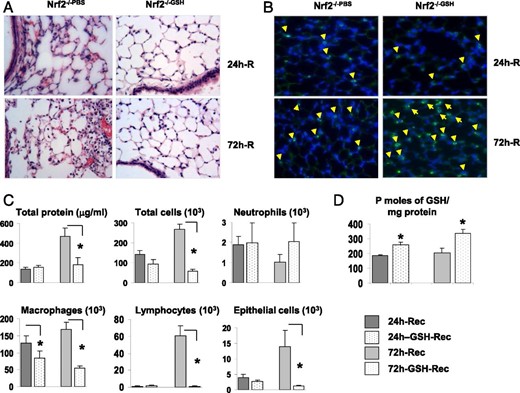-
PDF
- Split View
-
Views
-
Cite
Cite
Narsa M Reddy, Steven R Kleeberger, Thomas W Kensler, Masayuki Yamamoto, Paul M Hassoun, Sekhar P Reddy, Correction: Disruption of Nrf2 Impairs the Resolution of Hyperoxia-Induced Acute Lung Injury and Inflammation in Mice, The Journal of Immunology, Volume 198, Issue 9, May 2017, Page 3755, https://doi.org/10.4049/jimmunol.1700291
Close - Share Icon Share
Reddy, N. M., S. R. Kleeberger, T. W. Kensler, M. Yamamoto, P. M. Hassoun, and S. P. Reddy. 2009. Disruption of Nrf2 impairs the resolution of hyperoxia-induced acute lung injury and inflammation in mice. J. Immunol. 182: 7264–7271.
During the assembly of Fig. 7B, a panel from Fig. 4A was inadvertently incorporated for the 72 h–recovered PBS control group of Nrf2−/− mice (B, bottom left). Fig. 7 with the correct image is shown below. The figure legend was correct as published and is shown below for reference. The authors regret this inadvertent error, and they strongly believe that this correction does not change the scientific content, interpretations, or conclusions reached in the article.

Effects of exogenous GSH on hyperoxia-induced lung inflammation and injury: Nrf2−/− mice immediately after 48-h hyperoxia were given GSH ester (5 mmol/kg body weight) or vehicle PBS at every 24 h for 3 days and lungs were harvested. Lungs sections and BAL analyses were done as described above. A, Histology of lungs isolated from mice supplemented with PBS or GSH ester at 24 and 72 h (top panel) in recovery. B, Lung sections were immunostained using anti-SPC Abs to visualize the presence of type II epithelial cells. The positively stained cells are indicated with arrows. Images shown are representative of lung section from three different mice in each group. C, Graphs represent the total protein, total cells, neutrophils, macrophages, lymphocytes and epithelial cells in the BAL fluid. D, Graph represents the GSH levels in the lungs of Nrf2−/− mice at 24- and 72-h recovery following GSH supplementation. *, p < 0.001 versus Nrf2−/− GSH-supplemented mice (n = 3).



